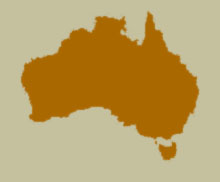Synonyms
Orcus citri Lea, 1902: 489.
Orcus coxalis Weise, 1918: 221.
Diagnosis
Orcus citri is a very distinctive species with its small, very convex, almost circular form and dark elytra. It is also distinctive in having 8-segmented antennae and middle and hind tibiae that lack the sharp outer tooth found in most of the Orcus species.
Description
Length 2.8-2.9 mm. Male. Head and elytra metallic brownish; prothorax yellowish, except central area of pronotum, which is brownish; antennae, labrum, labial palp, ventral surface of fore legs, meso- and metepimeron, meso- and metepisternum yellowish to pale brown; abdominal ventrites yellowish except in the area between the postcoxal lines. Body rounded, convex. Head micro reticulate between punctures; punctation about as large as eye facets, nearly 1 diameter apart. Eyes with inner margin conspicuously diverging apically. Antenna 8-segmented; pedicel about as long as greatest width; 3rd antennomere slightly shorter than pedicel; 8th broad, slightly longer than basal width. Terminal maxillary palpomere with side parallel; terminal labial palpomere slightly elongate; about 2 times longer than basal width; shorter then preceding segment. Pronotal surface polished between punctures; punctation about as large as eye facets, as shallow as on head, approximately 1.0 diameters apart; the punctures not confluent on anterior angles, getting only slightly deeper and larger; anterior angles without distinct strigae; lateral borders rounded; bordering line uninterrupted at base, the line slightly opening anteriorly, then almost reaching lateral margin; prosternum short in front of coxae slightly longer than prosternal process widest width; hypomeral foveae absent; hind tibiae without outer tooth; tarsal claws weakly appendiculate. Elytral surface and punctation as on pronotum; lateral margin not reflexed, with clear bead; epipleural foveae absent. Abdomen with 6 ventrites; 6th very reduced, truncate to slightly emarginate at apex; surface of ventrite 1 micro reticulate between postcoxal lines; postcoxal lines separated at middle, running parallel to posterior margin of ventrite for a short distance.
Male
Tegmen relatively long, about 2/3 the abdomen length; penis guide symmetrical, distinctly longer than parameres; parameres densely setose at apex, the setae relatively short; strut slightly shorter than tegmen; penis as figured.
Female
Female externally similar to male, except having monochromatic pronotum and only 5 visible abdominal ventrites; the 5th ventrite is rounded apically.
Variation
Unknown.
 Distribution and Biology
Distribution and Biology
Known from few localities along the coast from central New South Wales to northern Queensland. A. Lea found this species on orange trees. Some specimens were found on Casuarina sp. in association with larvae and probably when preying on the scale, Pseudoripersia turgipes (Maskell).
Species References
Lea, A. M. 1902. Descriptions of new species of Australian Coleoptera. Proceedings of the Linnean Society of New South Wales, 1901: 481-513.
Slipinski, S.A. 2007. Australian Ladybird Beetles (Coleoptera: Coccinellidae) their biology and classification. ABRS, Canberra. 286 pp.
Slipinski, A. and Giorgi, J.A. 2006. Revision of the Australian Coccinellidae (Coccinellidae). Part 6. Tribe Chilocorini. Annales Zoologici (Warszawa), 56(2): 265-304.
Weise, J. 1918. Chrysomeliden und Coccinelliden aus Nord-Neu-Guinea, gesammeld von Dr. P.N. van Kampen und K. Gjellerup, in den Jahren 1910 und 1911. Tijdschrift voor Entomologie, 60 (1917): 192-224.
[ Top ]
